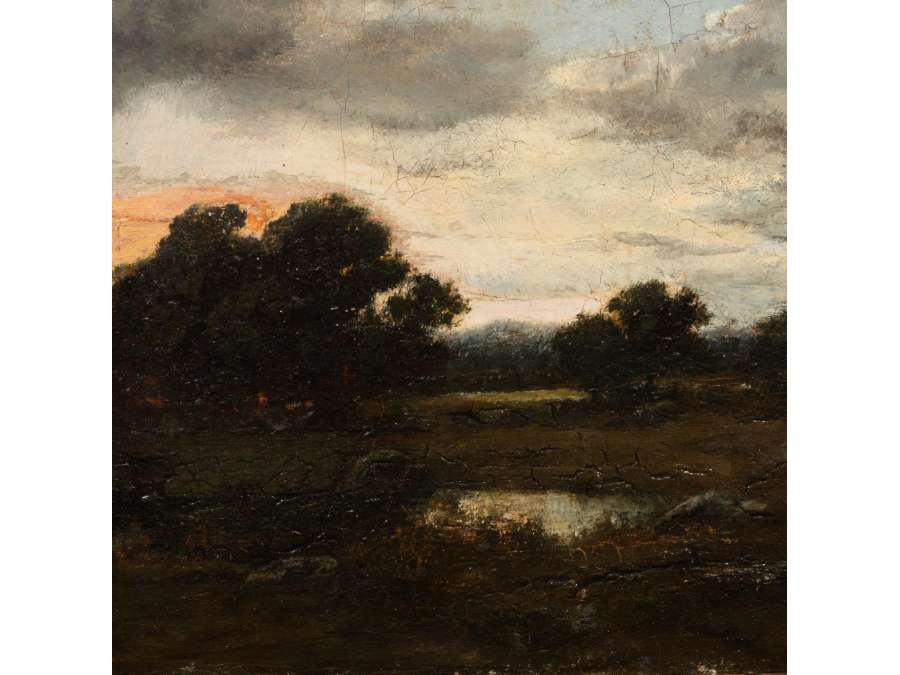Dusk
Dimensions: (h) 28 cm x 49 cm (w) (canvas)
Narcisse-Virgil Diaz de la Pena (1807 - 1876): Biography
Narcisse Diaz de la Peña was a French landscape and figure painter, a founding member of the avant-garde Barbizon school. Born in Bordeaux in 1807 to Spanish parents, he was orphaned at the age of 10, penniless, and was entrusted to a priest in Bellevue near Paris. The young Narcissus, who, after an unfortunate accident, lost one of his legs due to blood poisoning, became famous with his "wooden stump" and apprenticed in the workshops of Sèvres at the age aged 15, where he painted porcelain. The hard work soon took its toll on Diaz, and he began painting his own compositions, mostly of rich oriental subjects.
As was common practice at the time, Narcisse learned to paint by studying the masters at the Louvre, where he was attracted to the works of the colorists. He draws particular inspiration from Correggio, whose Antiope he takes up and interprets in his own Sleeping Nymph (at the Louvre) and in the two sketches from the Wallace Collection, Venus Disarming Love and The Education of Love. He was also influenced by Prud'hon whose Venus and Adonis inspired a work by Narcisse of the same title (now in the Louvre). In his paintings, intended for a certain caste of the Second Empire, Narcisse also borrows from 18th century painters, specifically Watteau.
Among his contemporaries, Narcisse suffered two great influences: Eugène Delacroix with his orientalist nymphs, Turks and Bohemians, and Théodore Rousseau, with whom he befriended at Barbizon in 1836 and who gave him a taste for the Dutch masters.
Narcisse exhibited for the first time at the Salon from 1831 to 1837. From 1837 to 1844, he was an important and influential member of the Barbizon school. Over the next few years, he received three gold medals from the Salon for painting, and in 1851 he was named a Chevalier of the Legion of Honor. With the Salon of 1848, the Barbizon school became a recognized movement, which dominated French landscape painting until the end of the 1860s.
Before the 19th century, artists drew, but rarely painted outdoors. In the middle of the century, the painting of small open-air studies was common to Corot and the Barbizon school. In Barbizon, Rousseau, Diaz and their friends had rediscovered nature with Corot and Daubigny. Although the individual methods and concepts of the Barbizon painters differed considerably, they had in common a complete devotion to nature and a desire to be faithful to their observations. Diaz specialized in dark wooded interiors in which patches of light or bands of sky shining through the branches create dramatic contrasts. A fanatical opponent of line as well as smooth academic technique, he loved the color and rough texture of heavily applied paint.
Art historians have tried to confine Narcissus to a single school – Barbizon – but Narcissus was a free spirit and followed his own instincts.
In 1851 he built his own studio in Paris, and it was there that he became sociable and entertaining for several years. In the 1870s, his works became fashionable and their value increased year by year.
Diaz married and had two sons, Emile, who showed some artistic talent, and Eugène, who became a musician. He lived in prosperity and honor, and died in Menton in 1876.
Collections of paintings by Diaz de la Peña can be admired at the Louvre, the Musée de Reims, the Metropolitan Museum of Art in New York, the Museum of Fine Arts in Boston, the Cincinnati Art Museum, in London (National Gallery, Victoria and Albert Museum, Wallace Collection) and in The Hague (Mesdag Museum).

 Français
Français  English
English


























